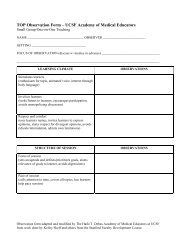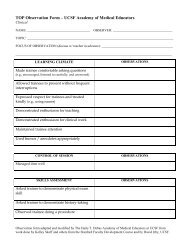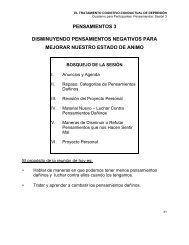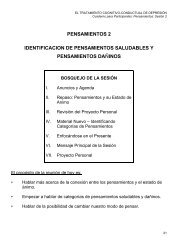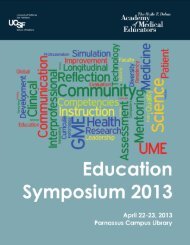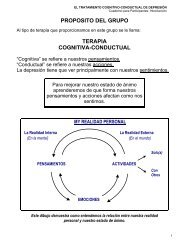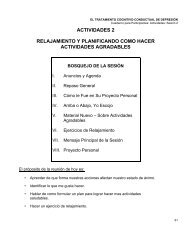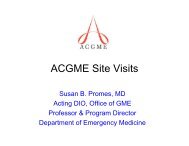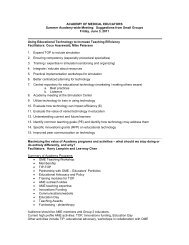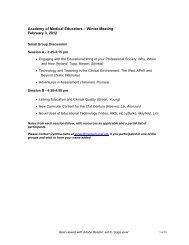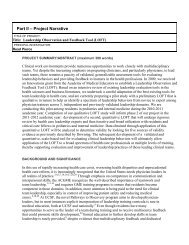<strong>UCSF</strong> Education Day <strong>2011</strong>TOP mentees will continue to evaluate their mentors'performance.Dissemination: We plan to publish this tool on Med EdPortal and present at national medical educationmeetings.Reflective critique: A team <strong>of</strong> eight AME membersprovided input. This project was presented at the TLCSopening, and valuable input was received. After welaunch the training module, adjustments will be madebased on feedback from users.Competency-Based Curricula for theHealth Pr<strong>of</strong>essions in TanzaniaHelen Loeser, MD, MSc, <strong>UCSF</strong> <strong>School</strong> <strong>of</strong> <strong>Medicine</strong>,Helen.Loeser@ucsf.edu; Judy Martin-Holland, PhD,MPA, RN, CS, FNP <strong>UCSF</strong> <strong>School</strong> <strong>of</strong> Nursing,judy.martin-holland@nursing.ucsf.edu; SharonYoumans, PharmD, MPH, <strong>UCSF</strong> <strong>School</strong> <strong>of</strong> Pharmacy,youmanss@pharmacy.ucsf.edu; Peter Loomer, DDS,PhD, <strong>UCSF</strong> <strong>School</strong> <strong>of</strong> Dentistry, peter.loomer@ucsf.edu;Eligius Lyamuya, MD, Muhimbili <strong>University</strong> <strong>of</strong> Health andAllied Sciences, eligius_lyamuya@yahoo.com; PatriciaO’Sullivan, EdD, <strong>UCSF</strong> <strong>School</strong> <strong>of</strong> <strong>Medicine</strong>,OSullivanP@medsch.ucsf.eduAreas abstract covers: UME, GMEDomain(s) addressed: Competencies, CurricularInnovation, Global Health, Interpr<strong>of</strong>essional EducationPurpose: A strategic Tanzania-U.S. universitypartnership, formed to optimize the impact <strong>of</strong> healthpr<strong>of</strong>essions graduates on health outcomes in Tanzania,led to an interpr<strong>of</strong>essional collaboration to developcompetency-based curricula.Background: Competency-based education was newlymandated inTanzania and Muhimbili <strong>University</strong> <strong>of</strong> Healthand Allied Sciences (MUHAS) embarked upon a reviewand revision <strong>of</strong> their <strong>Medicine</strong>, Dentistry, Nursing,Pharmacy, and Public Health curricula. MUHAS soughtexpertise in undertaking the revision and incorporatingcompetencies into their teaching and assessment. Aninterpr<strong>of</strong>essional team from <strong>UCSF</strong> schools <strong>of</strong> dentistry,medicine, nursing and pharmacy provided consultation.Methods: Curriculum revision began in 2008 andincluded these key steps[1]: (1) extensive stakeholderconsultation; (2) determination <strong>of</strong> Tanzania's healthpriorities; (3) identification <strong>of</strong> competencies necessaryfor Tanzanian health pr<strong>of</strong>essionals; (4) faculty training incompetency-based education; (5) individual courserevision by faculty and (6) demonstrations by <strong>UCSF</strong>collaborators. Data and process that supported thesesteps included national surveys, focus groups,workshops and retreats.Evaluation Plan: By <strong>2011</strong>, curricula in all MUHASschools will be revised to include competency-basedobjectives, new strategies for instruction and studentassessment. Opportunities will be introduced for activelearning, clinical experience and structured fieldwork.Stakeholder consultation and periodic assessment <strong>of</strong>program outcomes by surveys <strong>of</strong> graduates andemployers are planned.Dissemination: MUHAS and <strong>UCSF</strong> faculty arepresenting this curriculum work and outcomes locally,regionally, and internationally. A website is inpreparation for sharing results, and supporting additionalregional and international collaborations.Reflective critique: There is ongoing exchange from allpartnership members evaluating progress to guidedecisions for next steps. MUHAS will pilot some aspects<strong>of</strong> the curriculum to ease the transition to the newapproach. Interpr<strong>of</strong>essional education collaborationshave been productive at MUHAS and <strong>UCSF</strong>.References:1. H. Loeser, P. O'Sullivan, D. Irby. Leadership Lessons fromCurricular Change at <strong>UCSF</strong> <strong>School</strong> <strong>of</strong> <strong>Medicine</strong>. Acad. Med. 82(4):324-330. April 2007Longitudinal Interpr<strong>of</strong>essionalCurriculum Well Received by First-Year Health Pr<strong>of</strong>essions StudentsJennifer Staves, MS3, <strong>UCSF</strong> <strong>School</strong> <strong>of</strong> <strong>Medicine</strong>;Alexandria Cerri, Sacred Heart Cathedral PreparatoryHigh <strong>School</strong>; Susan Hyde, DDS, MPH, PhD, <strong>UCSF</strong><strong>School</strong> <strong>of</strong> Dentistry; Brian Alldredge, PharmD, <strong>UCSF</strong><strong>School</strong> <strong>of</strong> Pharmacy; Sharon , PharmD, <strong>UCSF</strong> <strong>School</strong> <strong>of</strong>Pharmacy; Jeff Kilmer, MA, <strong>UCSF</strong> <strong>School</strong> <strong>of</strong> Nursing;Dorothy Perry, PhD, <strong>UCSF</strong> <strong>School</strong> <strong>of</strong> Dentistry; HelenLoeser, MD, MSc, <strong>UCSF</strong> <strong>School</strong> <strong>of</strong> <strong>Medicine</strong>; KimberlyTopp, PhD, PT, <strong>UCSF</strong> <strong>School</strong> <strong>of</strong> <strong>Medicine</strong>, Department<strong>of</strong> Physical Therapy; H. Carrie Chen, MD, MSEd, <strong>UCSF</strong><strong>School</strong> <strong>of</strong> <strong>Medicine</strong>Areas abstract covers: UMEDomain(s) addressed: Communication, CurricularInnovation, Evaluation <strong>of</strong> Programs and Curricula,Interpr<strong>of</strong>essional EducationPurpose: We describe the implementation andevaluation <strong>of</strong> a novel interpr<strong>of</strong>essional curriculum forfirst-year dentistry, medicine, nursing, pharmacy, andphysical therapy students.Background: Promoting interpr<strong>of</strong>essional education(IPE) early in the training <strong>of</strong> health pr<strong>of</strong>essions studentscan help lay strong foundations for effective teamwork in<strong>University</strong> <strong>of</strong> <strong>California</strong>, <strong>San</strong> Francisco • <strong>School</strong> <strong>of</strong> <strong>Medicine</strong> 9
<strong>UCSF</strong> Education Day <strong>2011</strong>their future careers. We implemented a required yearlongcurriculum for all first-year health pr<strong>of</strong>essionsstudents. The curriculum included 2 half-day events(“IPE Days 1 & 2”) during which students collaborated ininterpr<strong>of</strong>essional teams <strong>of</strong> 9-10 students to addresshealthcare disparities and team communicationchallenges. Student teams also responded to four triggerquestions throughout the year using an online discussionforum.Methods: Students completed satisfaction surveys atthe end <strong>of</strong> each IPE Day and year using a 5-point Likertscale (1=strongly disagree, 5=strongly agree). Wedetermined utilization <strong>of</strong> the online forum by calculatingand categorizing student postings and identifying majorthemes.Results: 477 students participated in the curriculum.Students rated both IPE Days 1 and 2 as effective (Day1=4.06, Day 2=3.92) and relevant to their education(4.30, 4.06). 423 (88.9%) students participated in theonline forum generating 1205 postings. Studentresponse rate to the online questions decreased from83% to 26% over the year. Pharmacy students had thehighest online participation rate (92% responded at leastonce) and nursing the lowest (81%, p=0.02). Majordiscussion themes are presented.Discussion: We successfully implemented a novelinterpr<strong>of</strong>essional curriculum which was well received byfirst-year health pr<strong>of</strong>essions students. However, use <strong>of</strong>the online forums declined over time, suggesting theneed for further curricular refinements to sustainparticipation.Reflection: Input from faculty from all participatingschools was critical to the success <strong>of</strong> thisinterpr<strong>of</strong>essional initiative. Student feedback wasgathered via online and paper surveys, and was used toinform the expansion and refinement <strong>of</strong> the curriculum.What's Really So Different aboutLongitudinal Integrated Clerkships(LICs) and Block Clerkships?Findings from a Multi-CenterObservational, Work Sampling StudyBridget O'Brien, PhD, <strong>UCSF</strong>, bridget.obrien@ucsf.edu;Ann Poncelet, MD, <strong>UCSF</strong>, ann.poncelet@ucsf.edu; LoriHansen, MD, <strong>University</strong> <strong>of</strong> South Dakota, <strong>San</strong>ford<strong>School</strong> <strong>of</strong> <strong>Medicine</strong>, lori.hansen@usd.edu; David Hirsh,MD, Harvard Medical <strong>School</strong>, dhirsh@challiance.org;Barbara Ogur, MD, Cambridge Hospital, HarvardMedical <strong>School</strong>; Edward Krupat, PhD, Harvard Medical<strong>School</strong>; Erik Alexander, MD, Harvard Medical <strong>School</strong>,ealexander@partners.org; Iris Ma, <strong>UCSF</strong>; Karen Hauer,MD, <strong>UCSF</strong>, khauer@medicine.ucsf.eduAreas abstract covers: UMEDomain(s) addressed: Evaluation <strong>of</strong> Programs andCurricula, Longitudinal Educational ActivitiesPurpose: To compare direct and independent patientcare activities <strong>of</strong> longitudinal integrated clerkship (LIC)and block students at three medical schools.Background: Studies suggest that students in LICsmaintain more patient-centeredness throughout the yearcompared to students in block clerkships. Theexplanation may rest in students’ involvement in directpatient care activities.Methods: We conducted a yearlong, observational,work sampling study at 3 US medical schools with LICand block clerkships. Trained observers documentedstudents’ activities and level <strong>of</strong> participation every 10minutes for 4-hour periods in internal medicine andobstetrics-gynecology. In this analysis, we comparestudents’ participation in direct patient care activities inthe last three months <strong>of</strong> the clerkship year. Each studentwas observed 1-4 times. The observation session is theunit <strong>of</strong> analysis. Data analysis included calculatingmedian percentages <strong>of</strong> session time and Mann-WhitneyU-tests comparing percentage <strong>of</strong> session time that LICand block students’ engage in direct and independentpatient care activities.Results: We observed 44 students (28 LIC,16 block),resulting in 91 late year observations. Despite somedifferences among schools, LIC students overall spentsignificantly more time engaged in direct patient carecompared to block students (45%vs.35%,p=0.040) andmore time performing these direct patient care activitiesindependently than block students (25%vs.9%,p



